RENEGADE GARDENER™
The lone voice of horticultural reason
Don’t Forget Fragrance
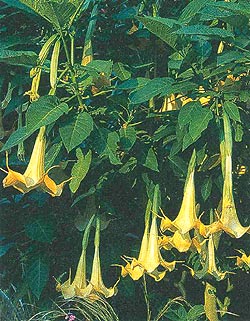 |
| Brugmansia ‘Charles Grimaldi’ (Angel’s Trumpet) |
9-21-04–I love the smell of shredded hardwood mulch in the morning. It smells like … gardening. But does it really? Ask me a few months ago to name plants that fill the air with pleasant aromas, and I’m afraid you’d have endured a lengthy pause, while I scrambled to come up with anything beyond my short list of lilacs, angel’s trumpet, and a few rose varieties.I certainly drew a blank when the question was raised by an avid St. Paul gardener with whom I visited this spring. A native to India, he was expanding his already attractive, meticulously maintained foundation plantings and gardens and wanted me to recommend new shrubs and perennials that would blend in with the old. I launched into my standard babblings about form and foliage, confident I was earning my keep, until he dropped me with a question concerning, of all things, fragrance. “In India,” he said, “we choose our plants for their fragrance as much as other factors. Suggest some plants I can grow here that will fill my yard with pleasant scents, and that I will smell inside the house when the windows are open.”
It was an ugly scene: The Renegade Gardener Unmasked. If I’ve learned one thing in life, it’s that when backed into a corner, grudgingly revert to the truth. I confessed to him that while I was somewhat capable of combining plants so as to be pleasing to the eye, I wasn’t much help when it came to choosing attractive plants that also smelled nice. He graciously let me off the hook by noting that I was not alone. “It seems in America there is little concern for fragrance in the garden. All the books I read, the magazines and catalogs, looking up plants online, they always tell you about height and flower color and necessary light conditions, but rarely do they mention if the plant emits a pleasant scent.”
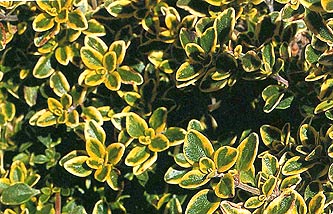 |
| Thymus x citriodorus (Thyme) |
He was right. To a certain extent, fragrance in the garden has become a forgotten factor. It certainly has been ignored by rose hybridizers, who have become so preoccupied with supplying gardeners with new varieties that produce double blooms from spring to fall that when a plant’s ability to produce a discernable scent fell by the genetic wayside, they never looked back. This is why some gardeners have begun growing older rose varieties, so that even a small bouquet cut from their plants will grace the indoors with a pleasant perfume.
Many annuals and perennials we grow for their colorful flowers have had their fragrance steam-cleaned out of them as well, by plant scientists dickering with cells to create better disease-resistance, wilder foliage variations, and bigger blooms. Cut a large bouquet of annuals and perennials from most American gardens today and it’s very possible you won’t discern any scent from two feet away—odd when one considers that bouquet is a synonym for smell, after all.
As I puzzled through the causes for my odoriferous ignorance, an offhand comment made to me a few years back popped into my head. I was visiting the lovely garden of my friend and fellow garden writer Marge Hols, who writes a wonderful weekly gardening column for the St. Paul Pioneer Press. I mentioned to her that she didn’t seem to use any type of mulch around her perennials, choosing instead to employ the charming yet antiquated practice of plucking by hand the scant few weeds that dared grow in her lush and gorgeous garden. Why didn’t she simply use a weed-blocking mulch of cocoa bean husks, I asked?
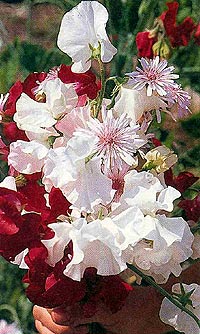 |
| Lathyrus odoratus (Sweet Pea) |
“I don’t like cocoa beans,” she replied. “I’d rather smell my garden.” Upon hearing this I remembered thinking two things, first, that’s quaint, and second, hold on there, Marge, I’ll be the snob here. But now I understand what she was saying. I’ve applied a fresh, two-inch layer of cocoa bean husks as mulch in my garden every year for the past ten, with nary a thought about the fact that for a week after applying the husks, and again after each rainfall, my yard smells like I’ve been relocated downwind from the Hershey factory. This has never bothered me because I’ve never been terribly mindful of true garden fragrance. Marge has, and smartly would rather smell her garden.So as a nod to wise Marge, an answer to my astute gardening friend in St. Paul, and for my own edification, I’ve spent some time researching the heavenly realm of aromatic plants that can be grown in the Twin Cities. I am certain to have missed some; please e-mail me if one of your favorites escaped my investigation. I’m a gardener, after all, and not the least bit embarrassed to admit that being a gardener is to exist in a perpetual state of learning.
Aromatic Annuals
- Alyssum (Lobularia maritima)
- Angel’s Trumpet (Brugmansia/Datura)
- Dianthus (Dianthus spp.)
- Heliotrope (Heliotropum arboresccens)
- Moonflower (Ipomoea alba)
- Flowering Tobacco (Nicotiana spp.)
- Nasturtium (Tropaeolum majus)
- Petunia (Petunia spp.)
- Stocks (Matthiola incana)
- Sweet Pea (Lathyrus odoratus)
- Sweet William (Dianthus barbatus)
- Sweet Sultan (Centaurea moschata)
Perfumed Perennials
- Lily-of-the-Valley (Convallaria majalis)
- Pinks (Dianthus gratianopolitanus)
- Gas Plant (Dictamnus albus)
- Queen-of-the-Meadow (Filipendula ulmaria)
- Sweet Woodruff (Galium odoratum)
- Heliotrope (Heliotropium aborescens)
- Iris (Iris spp.)
- Lavender (Lavandula angustifolia)
- Bee Balm (Monarda didyma)
- Evening Primrose (Oenothera odorata)
- Peony (Paeonia spp.)
- Thyme (Tymus spp.)
Scented Shrubs – Fragrant Leaves
- Arborvitae (Thuja)
- Boxwood (Buxus)
- Sweet Fern (Comptonia peregrina)
- Wintergreen (Gaultheria procumbens)
- Bayberry (Myrica pensylvanica)
- Sumac (Rhus aromatica)
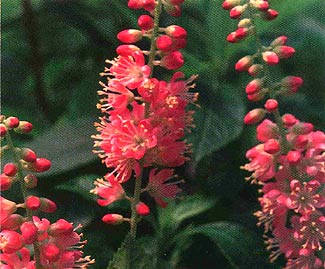 |
| Clethra alnifolia ‘Ruby Spice’ |
Scented Shrubs – Fragrant Flowers
- Buddleia (Buddleia davidii)
- Fringetree (Chionanthus virginicus)
- Summersweet (Clethra alnifolia)
- Daphne (Daphne x burkwoodii)
- Deutzia (Deutzia gracilis)
- Russian Olive (Elaeagnus angustifolius)
- Fothergilla (Fothergilla major)
- Witchhazel (Hamamelis virginiana)
- Mockorange (Philadelphus coronarius)
- Azalea (Rhododendron spp.)
- Rhododendron (Rhododendron spp.)
- Lilac (Syringa spp.)
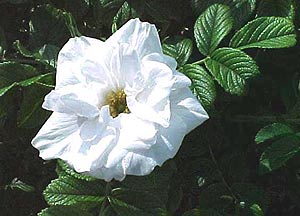 |
| Rosa ‘Blanche Double de Coubert’ |
Don Engebretson
The Renegade Gardener